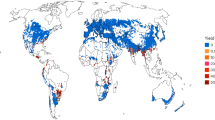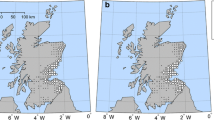Abstract
Climate change will affect both growth of agricultural crops and diseases that attack them but there has been little work to study how its impacts on crop growth influence impacts on disease epidemics. This paper investigates how impacts of climate change on wheat anthesis date will influence impacts on fusarium ear blight in UK mainland arable areas. A wheat growth model was used for projections of anthesis dates, and a weather-based model was developed for use in projections of incidence of fusarium ear blight in the UK. Daily weather data, generated for 14 sites in arable areas of the UK for a baseline (1960–1990) scenario and for high and low CO2 emissions in the 2020s and 2050s, were used to project wheat anthesis dates and fusarium ear blight incidence for each site for each climate change scenario. Incidence of fusarium ear blight was related to rainfall during anthesis and temperature during the preceding 6 weeks. It was projected that, with climate change, wheat anthesis dates will be earlier and fusarium ear blight epidemics will be more severe, especially in southern England, by the 2050s. These projections, made by combining crop and disease models for different climate change scenarios, suggest that improved control of fusarium ear blight should be a high priority in industry and government strategies for adaptation to climate change to ensure food security.






Similar content being viewed by others
References
Anderson, P. K., Cunningham, A. A., Patel, N. G., Morales, F. J., Epstein, P. R., & Daszak, P. (2004). Emerging infectious disease of plants: pathogen pollution, climate change and agrotechnology drivers. Trends in Ecology and Evolution, 19, 535–544.
Anonymous. (2009). 1.02 billion people hungry; one sixth of humanity undernourished—more than ever before. FAO (Food and Agriculture Organisation of the United Nations). Retrieved June 19, 2009 from http://www.fao.org/news/story/en/item/20568/icode/
Barnes, A. P., Wreford, A., Butterworth, M. H., Semenov, M. A., Moran, D., Evans, N., & Fitt, B. D. L. (2010). Adaptation to increasing severity of phoma stem canker on winter oilseed rape in the UK under climate change. Journal of Agricultural Science, 148, 683–694.
Butterworth, M. H., Semenov, M. A., Barnes, A., Moran, D., West, J. S., & Fitt, B. D. L. (2010). North-south divide: contrasting impacts of climate change on crop yields in Scotland and England. Journal of the Royal Society Interface, 7, 123–130.
Chakraborty, S. (2005). Potential impact of climate change on plant-pathogen interactions. Australasian Plant Pathology, 34, 443–448.
Chakraborty, S., & Newton, A. C. (2011). Climate change, plant diseases and food security: an overview. Plant Pathology 60 (in press).
Chakraborty, S., Tiedemann, A. V., & Teng, P. S. (2000). Climate change: potential impact on plant diseases. Environmental Pollution, 37, 399–426.
Chakraborty, S., Liu, C. J., Mitter, V., Scott, J. B., Akinsanmi, O. A., Ali, S., et al. (2005). Pathogen population structure and epidemiology are keys to wheat crown rot and Fusarium head blight management. Australasian Plant Pathology, 35, 643–655.
Coakley, M., Scherm, H., & Chakraborty, S. (1999). Climate change and plant disease management. Annual Review of Phytopathology, 37, 399–426.
Collins, M., Tett, S. F. B., & Cooper, C. (2001). The international climate variability of HadCM3, a version of the Hadley Centre coupled model without flux adjustments. Climate Dynamics, 17, 61–81.
De Wolf, E. D., & Isard, S. A. (2007). Disease cycle approach to plant disease prediction. Annual Review of Phytopathology, 45, 203–220.
De Wolf, E. D., Madden, L. V., & Lipps, P. E. (2003). Risk assessment models for wheat fusarium head blight epidemics based on within-season weather data. Phytopathology, 93, 428–35.
Del Ponte, E. M., Fernandes, J. M. C., & Pavan, W. (2005). A risk infection simulation model for Fusarium head blight of wheat. Fitopatologia Brasileira, 30, 634–642.
Evans, N., Baierl, A., Semenov, M. A., Gladders, P., & Fitt, B. D. L. (2008). Range and severity of a plant disease increased by global warming. Journal of the Royal Society Interface, 5, 525–531.
Evans, N., Butterworth, M. H., Baierl, A., Semenov, M. A., West, J. S., Barnes, A., et al. (2010). The impact of climate change on disease constraints on production of oilseed rape. Food Security, 2, 143–156.
Ewert, F., Rodriguez, D., Jamieson, P., Semenov, M. A., Mitchell, R. A. C., Goudriaan, J., et al. (2002). Effects of elevated CO2 and drought on wheat: testing crop simulation models for different experimental and climatic conditions. Agriculture Ecosystems and Environment, 93, 249–266.
Garrett, K. A., Dendy, S. P., Frank, E. E., Rouse, M. N., & Travers, S. E. (2006). Climate change effects on plant disease: genomes to ecosystems. Annual Review of Phytopathology, 44, 489–509.
Goswami, R. S., & Kistler, H. C. (2004). Heading for disaster: Fusarium graminearum on cereal crops. Molecular Plant Pathology, 5, 515–525.
Gregory, P. J., Johnson, S. N., Newton, A. C., & Ingram, J. S. (2009). Integrating pests and pathogens into the climate change/food security debate. Journal of Experimental Botany, 60, 2827–2838.
Holdgate, S. (2009). Improving the diversity of race non-specific resistance mechanisms available in wheat to combat fusarium ear blight disease. PhD thesis, Cranfield University, UK.
Hughes, D. J., West, J. S., Atkins, S. D., Gladders, P., Jeger, M. J., & Fitt, B. D. L. (2011). Effects of disease control by fungicides on Greenhouse Gas (GHG) emissions by UK arable crop production. Pest Management Science (in press).
Hulme, M., Jenkins, G. J., Lu, X., Turnpenny, J. R., Mitchell, T. D., Jones, R. G., et al. (2002). Climate change scenarios for the United Kingdom: The UKCIP02 scientific report, tyndall centre for climate change research (p. 120). Norwich: School of Environmental Sciences, University of East Anglia.
Jamieson, P. D., & Semenov, M. A. (2000). Modelling nitrogen uptake and redistribution in wheat. Field Crops Research, 68, 21–29.
Jamieson, P. D., Semenov, M. A., Brooking, I. R., & Francis, G. S. (1998). Sirius: a mechanistic model of wheat response to environmental variation. European Journal of Agronomy, 8, 161–179.
Lancashire, P. D., Bleiholder, H., van den Boom, T., Langeluddeke, P., Stauss, R., Weber, E., et al. (1991). A uniform decimal code for growth stages of crops and weeds. Annals of Applied Biology, 119, 561–601.
Luo, Y., Tebeest, D. O., Teng, P. S., & Fabellar, N. G. (1995). Simulation studies on risk analysis of rice leaf blast epidemics associated with global climate change in several Asian countries. Journal of Biogeography, 22, 673–678.
Madden, L. V., & Paul, P. A. (2009). Assessing heterogeneity in the relationship between wheat yield and fusarium head blight intensity using random-coefficient mixed models. Phytopathology, 99, 850–860.
Mahmuti, M., West, J. S., Watts, J., Gladders, P., & Fitt, B. D. L. (2009). Controlling crop disease contributes to both food security and climate change mitigation. International Journal of Agricultural Sustainability, 7, 189–202.
Metz, B., Davidson, O. R., Bosch, P. R., Dave, R., & Meyer, L. A. (2007). Climate change 2007: Mitigation of climate change. Contribution of working group III to the fourth assessment report of the intergovernmental panel on climate change. New York: Cambridge University Press.
Miraglia, M., Marvin, H. J. P., Kleter, G. A., Battilani, P., Brera, C., Coni, E., et al. (2009). Climate change and food safety: an emerging issue with special focus on Europe. Food and Chemical Toxicology, 47, 1009–1021.
Moschini, R. C., Pioli, R., Carmona, M., & Sacchi, O. (2001). Empirical predictions of wheat head blight in the Northern Argentinean Pampas region. Crop Science, 41, 1541–1545.
Musa, T., Hecker, S., Vogelgsang, S., & Forrer, H. R. (2007). Forecasting of Fusarium head blight and deoxynivanol content in winter wheat with FusaProg*. European Plant Protection Organisation Bulletin, 37, 283–289.
Nakicenovic, N. (2000). Greenhouse gas emissions scenarios. Technological Forecasting and Social Change, 65, 149–166.
Paul, P. A., Lipps, P. E., De Wolf, E., Shaner, G., Buechley, G., Adhikari, T., et al. (2007). A distributed lag analysis of the relationship between Gibberella zeae inoculum density on wheat spikes and weather variables. Phytopathology, 97, 1608–1624.
Prandini, A., Sigolo, S., Filippi, L., Battilani, P., & Piva, G. (2009). Review of predictive models for Fusarium head blight and related mycotoxin contamination in wheat. Food and Chemical Toxicology, 47, 927–931.
Rossi, V., Giosue, S., Pattori, E., Spanna, F., & Del Vecchio, A. (2003). A model estimating the risk of Fusarium head blight on wheat. European Plant Protection Organisation Bulletin, 33, 421–425.
Schaafsma, A. W., & Hooker, D. C. (2007). Climatic models to predict occurrence of Fusarium toxins in wheat and maize. International Journal of Food Microbiology, 119, 116–125.
Semenov, M. A. (2007). Development of high-resolution UKCIP02-based climate change scenarios in the UK. Agricultural and Forest Meteorology, 144, 127–138.
Semenov, M. A. (2009). Impacts of climate change on wheat in England and Wales. Journal of the Royal Society Interface, 6, 343–350.
Stern, N. (2007). The economics of climate change: The Stern review. Cambridge: Cambridge University Press.
Tuck, G., Glendining, M. J., Smith, P., House, J. I., & Wattenbach, M. (2006). The potential distribution of bioenergy crops in Europe under present and future climate. Biomass and Bioenergy, 30, 183–197.
Windels, C. E. (2000). Economic and social impacts of fusarium head blight: changing farms and rural communities in the northern Great Plains. Phytopathology, 90, 17–21.
Xu, X.-M., & Nicholson, P. (2009). Community ecology of fungal pathogens causing wheat head blight. Annual Review of Phytopathology, 47, 83–103.
Xu, X.-M., Monger, W., Ritieni, A., & Nicholson, P. (2007). Effect of temperature and duration of wetness during initial infection periods on disease development, fungal biomass and mycotoxin concentrations on wheat inoculated with single, or combinations of, Fusarium species. Plant Pathology, 56, 943–956.
Xu, X.-M., Parry, D. W., Nicholson, P., Thomsett, M. A., Simpson, D., Edwards, S. G., et al. (2008). Within-field variability of Fusarium head blight pathogens and their associated mycotoxins. European Journal of Plant Pathology, 120, 21–34.
Yang, L., van der Lee, T., Yang, X., Yu, D., & Waalwijk, C. (2008). Fusarium populations on Chinese barley show a dramatic gradient in mycotoxin profiles. Phytopathology, 98, 719–727.
Acknowledgments
We thank the UK Biotechnology and Biological Sciences Research Council (BBSRC, Rothamsted Centre for Bioenergy and Climate Change ISPG), Department for Environment, Food and Rural Affairs (Defra, including the Sustainable Arable LINK programme, CLIMDIS project LK 09111) and HGCA for funding this research. We thank Sarah Holdgate, Rohan Lowe, Jim McVittie, Eric Ober and Aiming Qi for supplying date of anthesis, fusarium ear blight incidence and weather data, and Pierre Stratonovitch for assistance in using Sirius. UK weather data variables were calculated from Crown copyright data supplied by the UK Met Office.
Author information
Authors and Affiliations
Corresponding author
Rights and permissions
About this article
Cite this article
Madgwick, J.W., West, J.S., White, R.P. et al. Impacts of climate change on wheat anthesis and fusarium ear blight in the UK. Eur J Plant Pathol 130, 117–131 (2011). https://doi.org/10.1007/s10658-010-9739-1
Accepted:
Published:
Issue Date:
DOI: https://doi.org/10.1007/s10658-010-9739-1




